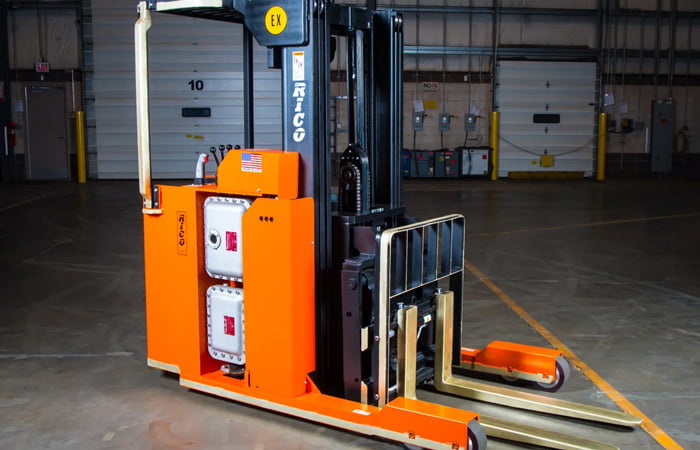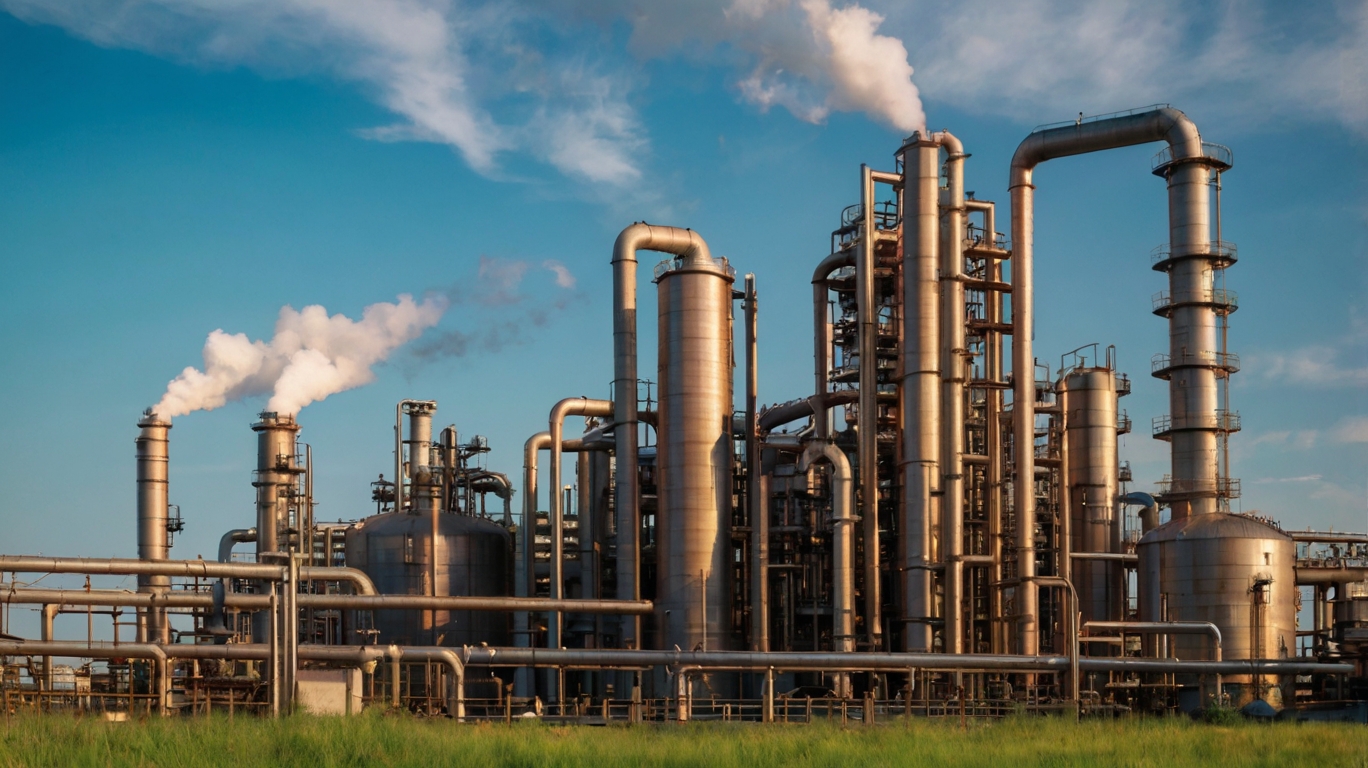
Definition: Explosion-proof devices are specially designed and constructed to prevent the ignition of flammable gases, vapors, dust, or fibers in hazardous environments. These devices are engineered to contain any internal explosion or spark, ensuring that it does not propagate to the surrounding atmosphere and cause a larger blast.
Science Behind It: The science behind explosion-proof devices involves meticulous engineering to suppress internal detonations and prevent the escape of sparks or flames. This is achieved through robust enclosures made from materials like cast aluminum, stainless steel, or cast iron, which can withstand the pressure and heat generated by an internal explosion. The design principles include ensuring that surface temperatures do not exceed levels that could ignite surrounding hazardous substances and providing pathways for gases to escape and cool down, preventing external ignition.
Types of Protection: Explosion-proof devices employ various protection methods, including:
- Flameproof Enclosures (Ex d): Designed to withstand internal explosions and quench flames as they exit the enclosure.
- Increased Safety (Ex e): Additional measures to prevent excessive temperatures and sparks.
- Pressurization (Ex p): Maintaining a positive internal pressure of protective gas to prevent explosive atmospheres.
- Intrinsic Safety (Ex ia, ib, ic): Ensuring that electrical equipment cannot release sufficient energy to ignite hazardous atmospheres even under fault conditions.
Examples in Action:
- Industrial Applications: Explosion-proof devices are crucial in industries such as oil and gas, chemical processing, mining, and manufacturing, where hazardous substances are common.
- Specific Products: Companies like International Metal Engineering specialize in making explosion-proof enclosures and junction boxes that meet strict safety standards set by organizations like the National Fire Protection Association (NFPA) and the International Electrotechnical Commission (IEC).
Global Safety Standards: These devices must comply with various international standards, including ATEX, IECEx, NEC, and CSA certifications, which ensure they meet rigorous safety requirements for use in hazardous environments[1][3][5].Fun Fact: Explosion-proof devices are so critical in hazardous environments that companies using certified explosion-proof equipment significantly reduce the risk of catastrophic explosions, thereby enhancing workplace safety and operational integrity. For instance, proper use of these devices can prevent the combination of fuel, ignition, and oxygen that is necessary for an explosion to occur, as outlined by the “Combustion Triangle”.
- Explosion-proof devices are engineered to contain internal explosions, preventing ignition of flammable gases or dust in hazardous environments, without implying resistance to external explosions.
- These devices utilize robust materials and designs such as flame paths to contain potential explosions and prevent sparks, supporting safety in industries like oil and gas.
- While explosion-proof equipment is crucial for hazardous environments, it should be part of a broader safety strategy including regular risk assessments and adherence to safety protocols.
Understanding Explosion-Proof Devices
Explosion-proof devices are an essential element in maintaining safety in hazardous environments. These specialized pieces of equipment are designed to prevent ignition of flammable gases, vapors, or dust within the industrial setting. The term “explosion-proof” might seem to imply that these devices can withstand an external explosion. In reality, it means that any explosion caused by components within the device will not escape and, thus, not trigger a larger, external blast in the surrounding atmosphere.
At their core, explosion-proof devices are built to contain any internal failure that could potentially cause sparks or excessive heat. This is achieved through robust engineering practices, including the use of durable materials, thick enclosures, and specific designs that prevent the propagation of flames or explosive forces outside of the device. The principle behind these designs is not to prevent the internal explosion entirely but to contain it effectively, ensuring the safety of the surrounding environment and personnel.
For industries that operate in environments where the air is regularly filled with potentially explosive gases or dust — such as chemical manufacturing, pharmaceuticals, oil and gas, and even some areas of food production — the importance of using explosion-proof equipment cannot be overstated. These devices are meticulously tested and certified to meet strict safety standards, such as those set by ATEX (Europe) and NEC 500 or NEC 505 (United States), before being deemed safe for hazardous locations.
The Intrinsically Safe Store understands the critical nature of these certifications and the necessity for reliable explosion-proof devices in hazardous environments. Our product range includes a variety of explosion-proof solutions tailored to meet the stringent requirements of these high-risk areas. From lighting and communication devices to sensors and monitoring equipment, each product in our portfolio is selected for its ability to enhance safety and operational efficiency in challenging conditions.
Our commitment to sourcing and delivering the best hazardous area certified products is driven by our understanding of the industries we serve. We recognize the unique challenges faced by our clients operating in hazardous environments and strive to offer products that not just meet, but exceed, safety regulations. By incorporating explosion-proof devices from The Intrinsically Safe Store into your safety protocols, you’re taking a significant step towards mitigating risks and protecting both your workforce and assets.
In exploring explosion-proof devices, it is crucial to partner with experts who not only supply the equipment but also offer the guidance necessary to ensure its effective integration and use. With a decade of expertise and a mission to connect one billion safe solutions by 2030, The Intrinsically Safe Store is your trusted ally in navigating the complexities of hazardous area operations.

Ready to Enhance Your Safety in Hazardous Environments?
The Intrinsically Safe Store is your go-to destination for the latest in explosion-proof devices. Our commitment to safety, innovation, and quality service positions us as a leading provider of hazardous area certified products. We understand the critical nature of your operations and are dedicated to ensuring that you can perform your work safely and efficiently.
Why choose The Intrinsically Safe Store for your safety needs?
- Extensive Product Range: From custom-designed engineering solutions to off-the-shelf explosion-proof devices, we have everything your industry requires to operate safely in hazardous conditions.
- Expert Service: Our team of experts is passionate about providing WOW service and is always ready to assist you in finding the perfect solution to meet your safety requirements.
- Competitive Pricing: We are committed to offering the lowest prices without compromising on quality, ensuring you get the best value for your investment.
- Commitment to Innovation and Improvement: As we strive to connect one billion safe solutions by 2030, we continuously explore and incorporate the latest technologies to ensure the highest standards of safety and efficiency in your operations.
Don’t compromise on safety. Contact us today to explore our range of explosion-proof devices and discover how we can help you enhance safety in your hazardous work environment. Let’s take a step forward together in building a safer world.
The Science Behind Explosion-Proof Design
At the core of every explosion-proof device is a principle that is as fascinating as it is critical for safety: containing a potential explosion and preventing it from igniting a larger, secondary explosion in the surrounding atmosphere. This design philosophy is crucial for industries operating in hazardous environments, from chemical manufacturing to renewable energy production. But what exactly goes into the science of making a device truly explosion-proof?
Firstly, it’s essential to understand that ‘explosion-proof’ doesn’t mean impervious to explosions. Instead, these devices are constructed to contain any explosion that may originate within its housing. This is achieved through robust design features that can withstand the pressures of an internal explosion without rupturing. For example, the enclosures are built with thick, heavy-duty materials and are meticulously engineered to prevent any sparks or hot gases from escaping and igniting the atmosphere outside the device.
Another key component in the anatomy of explosion-proof devices is the flame path. In an event where internal combustion does occur, the flame path inside the device acts as a labyrinth, cooling down the explosive gases as they pass through it, thereby quenching flames before they can exit the enclosure and come into contact with the hazardous outside environment.
Furthermore, the principles of explosion protection acknowledge that prevention is just as crucial as containment. This is why explosion-proof devices are also designed to minimize the risk of internal sparks. Elements such as switches, circuits, and other potential sources of ignition are carefully insulated and isolated, ensuring that even if a malfunction occurs, the risk of it leading to an explosion is significantly reduced.
Temperature control is another critical aspect of the science behind explosion-proof design. Materials used in the construction of these devices are selected based on their ability to remain at a temperature below that which could ignite the surrounding atmosphere, no matter the operating conditions. This includes taking into account the heat generated by the device itself during normal operations.
The creation of explosion-proof devices involves a deep understanding of physics, chemistry, and engineering. Each product undergoes rigorous testing to meet global safety standards, ensuring they provide the highest level of protection in explosive atmospheres. This commitment to safety is a testament to the expertise and dedication of companies like The Intrinsically Safe Store, which specialize in providing solutions that not only meet but exceed these rigorous safety requirements.
By investing in explosion-proof devices, industries working in hazardous environments can shield their operations, their workers, and ultimately, the environment from the devastating impacts of explosions. The science behind explosion-proof design is not just about compliance or meeting standards; it’s about creating a safer, more secure future for everyone involved.
Materials and Technologies in Explosion-Proofing
When delving into the world of explosion-proof devices, understanding the materials and technologies utilized is essential for industries operating in hazardous environments. At The Intrinsically Safe Store, we are committed to serving clients with products that not only meet but exceed safety standards. By integrating cutting-edge technologies and robust materials, we ensure the highest level of protection and reliability in our explosion-proof devices, in line with our goal to connect one billion safe solutions by 2030.
Advanced Materials: Ensuring Durability and Safety
The materials used in manufacturing explosion-proof devices are meticulously chosen for their ability to withstand extreme conditions. High-strength aluminum alloys, stainless steel, and non-sparking materials are commonly employed. These materials are favored for their durability, corrosion resistance, and ability to dissipate heat effectively, essential traits that prevent ignition in explosive atmospheres. Our product range showcases devices crafted from these advanced materials, ensuring they meet the rigorous requirements of hazardous environments in sectors like chemical, pharmaceutical, and oil and gas industries.
Innovative Technologies: Elevating Safety Standards
Leveraging state-of-the-art technologies is pivotal in the design and function of explosion-proof devices. At The Intrinsically Safe Store, we conform to this principle by incorporating smart technologies that enhance operational safety and efficiency. Our devices are equipped with intrinsic safety barriers, which limit electrical energy within the device to levels that cannot ignite an explosive atmosphere. Furthermore, we utilize flameproof enclosures – designed to contain any explosions within the device and prevent them from spreading into the surrounding environment. These technologies, along with our commitment to continuous improvement and exploration, are integral in meeting our customers’ unique purchasing needs while ensuring their operations remain safe and uninterrupted.
As we continue to serve industries operating in hazardous conditions, our focus remains on delivering products that embody our core values of providing WOW service, passion for work, and gratitude towards everyone we work with. By staying at the forefront of advancements in materials and technologies, The Intrinsically Safe Store pledges to uphold and exceed the safety standards required in explosive-prone environments, aligning with our BHAG and ensuring our clients operate safely and efficiently, no matter the challenges they face.
Implementing Explosion-Proof Devices
Implementing explosion-proof devices in hazardous environments is crucial for maintaining safety, ensuring compliance, and promoting uninterrupted operational efficiency. Industries operating in potentially explosive atmospheres, such as chemical processing, pharmaceuticals, and oil and gas production, require specialized equipment designed to prevent ignition of flammable gases, vapors, or dust. By choosing explosion-proof devices, your organization takes a significant step toward mitigating risks and protecting assets and lives.
Understanding the Environment
Before implementation, it’s essential to understand the specific classification of the hazardous environment. This classification is based on the nature and concentration of flammable materials present. Identifying the correct zone, division, or class helps in selecting the appropriate explosion-proof devices that meet or exceed the safety standards required for that environment.
Selection of Explosion-Proof Devices
At The Intrinsically Safe Store, we offer a wide range of explosion-proof devices, including lighting, switches, sensors, and communication tools, each designed to operate safely within the most demanding conditions. Our expert service team is dedicated to assisting clients in selecting the right products that not only meet safety regulations but also align with their operational needs.
Custom Solutions for Unique Needs
We understand that every facility has unique safety and operation challenges. Our custom design engineering, fabrication, and integration capabilities enable us to provide tailored solutions that precisely fit your requirements. Whether you need a custom-designed explosion-proof lighting system or a tailored communication setup, our team possesses the expertise and resources to bring your vision to life.
Ensuring Compliance and Safety
Integrating explosion-proof devices into your operational ecosystem is more than just a regulatory requirement; it’s a commitment to the highest safety standards. Our products are certified for hazardous area use, ensuring they meet the rigorous criteria set by safety standards bodies. By partnering with us, you’re not just purchasing a product; you’re investing in peace of mind knowing that your operations are equipped with devices that offer superior protection in hazardous environments.
Remember, implementing explosion-proof devices is a proactive step towards creating a safer work environment, minimizing risk, and enhancing productivity. With The Intrinsically Safe Store’s commitment to continuous improvement and passion for providing WOW service, we’re here to support your journey towards a safer, more efficient, and compliant facility. Together, let’s connect safe solutions that make a difference in the world.
Limitations of Explosion-Proof Equipment
While explosion-proof devices offer significant safety advantages in hazardous environments, it’s important to understand their limitations to ensure they are used effectively. These devices are designed to contain an explosion within the device itself and prevent the ignition of flammable materials in the surrounding atmosphere. However, they do not eliminate the risk of an explosion occurring within the device. Ensuring the safety of operations requires a comprehensive approach, including proper installation, maintenance, and adherence to safety protocols.
One key limitation is that explosion-proof equipment can be heavier and larger than non-explosion-proof counterparts due to the robust engineering required to contain explosions. This can make installation and maneuverability more challenging, particularly in tight spaces or environments where equipment needs to be moved or adjusted frequently.
Furthermore, explosion-proof devices are designed for specific hazardous classifications and might not be suitable for all types of explosive atmospheres. It’s crucial to choose the right type of equipment for the specific hazardous zone where it will be operated. Using a device designed for a less hazardous area in a more dangerous environment can lead to catastrophic results.
Another consideration is the increased initial cost and ongoing maintenance expenses. The specialized design and materials used in explosion-proof equipment often result in higher purchase prices. Moreover, maintenance needs to be carried out by qualified professionals who understand the intricacies of explosion-proof technology, potentially adding to the overall operating costs.
Lastly, it is essential to recognize that while explosion-proof devices play a critical role in maintaining safety, they must be part of a broader safety strategy. This strategy should include regular risk assessments, employee training, and the implementation of safety best practices. Relying solely on explosion-proof devices without a holistic approach to safety management can leave gaps in safety protocols.
Understanding these limitations is vital for businesses operating in hazardous environments. By recognizing the constraints and implementing a comprehensive safety plan that includes the appropriate use of explosion-proof equipment, companies can better protect their employees, assets, and operations from the risks associated with explosive atmospheres.
Comparing Explosion-Proof to Intrinsically Safe Devices
When navigating the complex landscape of safety in hazardous environments, understanding the distinction between explosion-proof devices and intrinsically safe devices is paramount. Both terms are often used interchangeably, but they represent fundamentally different approaches to safety.
Explosion-Proof Devices
Explosion-proof devices are designed to contain any explosion that originates within their housing. This means that even if an internal spark or explosion occurs, the device’s robust construction prevents the ignition of flammable gases or particles in the surrounding atmosphere. These devices are typically heavier and bulkier due to the need for reinforced casings. They are ideal for industries where high-powered equipment is essential, and the focus is more on containing explosions rather than preventing them outright.
Intrinsically Safe Devices
In contrast, intrinsically safe devices take a preventative approach. These devices are engineered to limit the electrical and thermal energy available for ignition to such a degree that sparks or high temperatures cannot occur, even under fault conditions. This inherent safety means that even in the presence of flammable materials, the risk of an explosion is significantly minimized. Intrinsically safe devices are often more lightweight and portable than their explosion-proof counterparts, providing flexibility and ease of use in sensitive environments.
Choosing the Right Protection
The decision between explosion-proof and intrinsically safe devices hinges on the specific requirements of the hazardous environment and the nature of the work being conducted. For industries that require the use of high-powered equipment under potentially explosive atmospheres, explosion-proof solutions may offer the necessary protection. Meanwhile, operations that benefit from portable, less power-intensive equipment in environments with explosive gases or dusts might find that intrinsically safe devices offer adequate protection without compromising on convenience or efficiency.
At The Intrinsically Safe Store, we understand the critical importance of selecting the right safety equipment for your needs. Our expert team is dedicated to guiding our clients through the myriad of options, ensuring compliance with industry standards and enhancing safety in hazardous environments. With our extensive product range and commitment to innovation and quality, we strive to empower our clients with the knowledge and tools needed to maintain safe and productive workplaces.
As we continue to explore explosion-proof devices and their crucial role in maintaining safety standards, it is clear that the choice between explosion-proof and intrinsically safe devices is not one to be taken lightly. Our mission is to connect industries with safe solutions that not only protect workers but also foster progress and efficiency.
FAQs on Explosion-Proof Devices: Ensuring Safety in Hazardous Environments
Can Explosion-Proof Devices Prevent All Types of Explosions?
Explosion-proof devices are designed to prevent ignition of hazardous substances in explosive atmospheres. While they greatly reduce the risk of initiating an explosion due to electrical or mechanical sparks, it’s important to understand that they cannot prevent all types of explosions. Their main function is to contain any explosion that originates within the device and prevent it from igniting the external atmosphere. Proper selection, installation, and maintenance are key to maximizing their effectiveness.
What are the Standards Governing Explosion-Proof Devices in the United States?
In the United States, explosion-proof device standards are primarily governed by the National Electric Code (NEC) and overseen by the National Fire Protection Association (NFPA). Additionally, devices must conform to standards set by the Occupational Safety and Health Administration (OSHA) and may require certification by recognized testing laboratories such as Underwriters Laboratories (UL) or Factory Mutual (FM). Compliance with these standards ensures that explosion-proof devices are safe to use in designated hazardous locations.
How Do I Choose the Right Explosion-Proof Device for My Needs?
Choosing the right explosion-proof device involves understanding the specific hazardous conditions of your environment. This includes knowing the class, division, and group of the hazardous location, which are delineated based on the types of flammable gases, vapors, or dust present. Consultation with a certified engineer or a specialized provider like The Intrinsically Safe Store can help identify the most suitable products for your particular needs, considering factors such as the device’s intended use, operating conditions, and compliance with relevant safety standards.
How Often Do Explosion-Proof Devices Need to Be Replaced or Serviced?
The lifespan of explosion-proof devices varies based on the type of device, environmental conditions, and frequency of use. Regular inspection and maintenance are crucial to ensure their ongoing reliability and safety. Manufacturers often provide recommended service intervals, but devices should be inspected at least annually to check for signs of wear, damage, or corrosion. Replacement is necessary if the device can no longer be safely used or fails to meet the required standards during inspection.
What Safety Precautions Should Be Taken When Using Explosion-Proof Devices?
Using explosion-proof devices safely requires adherence to several precautions:
- Ensure proper installation and grounding by qualified personnel.
- Regularly inspect and maintain devices according to manufacturer guidelines.
- Keep detailed records of maintenance, inspections, and any incidents to facilitate ongoing safety management.
- Train all relevant staff on the safe operation and emergency procedures related to explosion-proof equipment.
- Follow all local, national, and industry-specific regulations and best practices for working in hazardous environments.
Remember, while explosion-proof devices play a critical role in enhancing workplace safety, they are most effective when part of a comprehensive safety strategy that includes risk assessment, employee training, and emergency preparedness.



























